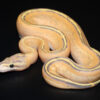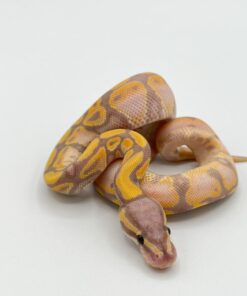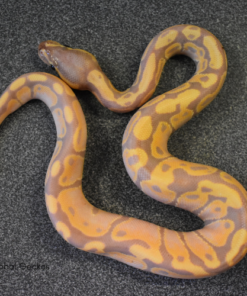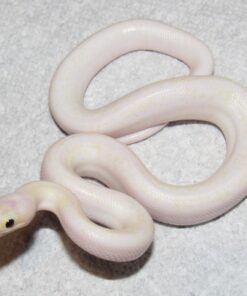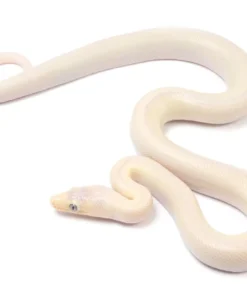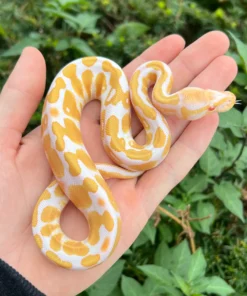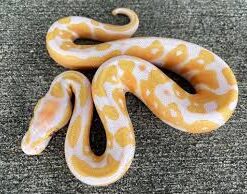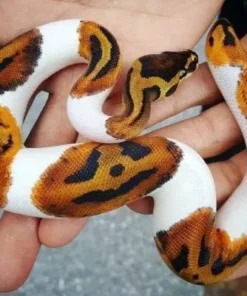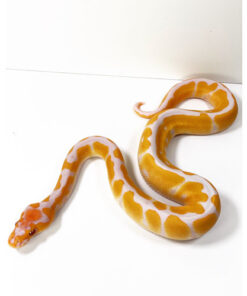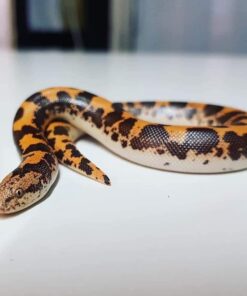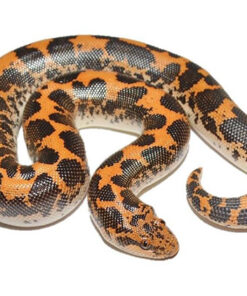$299.00
Gender: Both Male And Female Available
Weight: Approximately 50-160 grams
Diet: Live and Frozen/Thawed Medium Mice
Image: Representative Image
Breed: Puma Ball Python
Puma Ball Python For Sale
Puma Ball Python For Sale: A Comprehensive Guide to One of the Most Unique and Captivating Morphs
Puma Ball Python the world of ball pythons is full of incredible diversity and beauty, with breeders constantly working to create stunning new color and pattern variations. One such morph that has gained significant attention is the *Puma Ball Python*. This snake, a combination of different genes that result in a truly striking appearance, is a fantastic addition to any reptile enthusiast’s collection. Whether you are new to owning snakes or a seasoned reptile keeper, the *Puma Ball Python* offers an intriguing combination of aesthetic appeal and manageable care requirements.
If you’re looking for a *Puma Ball Python for sale* or simply want to learn more about these beautiful snakes, you’ve come to the right place. This guide will cover everything you need to know about the *Puma Ball Python*, including its genetic background, care requirements, morph variations like the *Pastel Puma Ball Python* and *Phantom Puma Ball Python*, and much more.
What is a Puma Ball Python?
The *Puma Ball Python* is a morph, meaning it has been bred to express a unique combination of traits that differ from the standard ball python. The main trait responsible for the “Puma” appearance is a specific genetic combination of the Yellowbelly and Spark genes. When these two genes come together, they create the *Puma Ball Python*, a snake with a smooth, almost metallic appearance, often featuring shades of gold, tan, and orange, along with subtle but striking patterns.
This morph was developed through selective breeding, with breeders aiming to bring out the best of the Spark and Yellowbelly genes to create something truly unique. The result is a morph that is not only visually captivating but also possesses the same temperament and care requirements that make ball pythons one of the most popular pet snakes in the world.
The Genetic Makeup of a Puma Ball Python
Understanding the genetics behind the *Puma Ball Python* is key to appreciating its unique appearance. The *Puma Ball Python* is the result of combining the following two primary genes:
1. **Yellowbelly Gene**: The Yellowbelly gene is a co-dominant trait that enhances color, creating a brighter and more vibrant snake. On its own, the Yellowbelly gene may not appear particularly extraordinary, but when paired with other genes, it brings out striking, high-contrast patterns.
2. **Spark Gene**: The Spark gene is another co-dominant gene, and while it doesn’t create dramatic changes on its own, it works in synergy with the Yellowbelly gene to create the “Puma” effect. The combination of these two genes results in a smooth, clean pattern with golden tones and a faint dorsal stripe.
When bred together, these genes interact to create the *Puma Ball Python*, a snake that often appears almost iridescent, with subtle but beautiful markings. This morph is highly sought after due to its elegant appearance and the potential for further morph combinations.
Popular Variations: The Pastel Puma Ball Python and
As with many ball python morphs, breeders have worked to combine the *Puma Ball Python* with other morphs to create even more stunning variations. Two particularly popular and eye-catching versions are the *Pastel Puma Ball Python* and the *Phantom Puma Ball Python*.
The Pastel Puma Ball Python
The *Pastel Puma Ball Python* is created by adding the *Pastel gene* into the mix. The Pastel gene is another co-dominant trait that lightens the snake’s overall color, often creating a brighter, more vibrant appearance. When combined with the Yellowbelly and Spark genes, the Pastel gene enhances the already beautiful golds and tans of the *Puma Ball Python*, making the colors more vibrant and the patterns more defined.
A *Pastel Puma Ball Python* will typically have brighter yellows, more contrasting markings, and an overall cleaner appearance compared to a standard *Puma Ball Python*. This morph is popular for its striking visual appeal and is often considered a must-have for ball python enthusiasts who appreciate bright, bold colors.
The Phantom Puma Ball Python
The *Phantom Puma Ball Python* introduces the *Phantom gene*, a subtle yet transformative gene that adds depth and richness to the snake’s coloration. The Phantom gene, a co-dominant morph, is known for creating darker, more muted tones, often resulting in a snake with an ethereal, ghost-like appearance.
When combined with the Puma morph, the *Phantom Puma Ball Python* takes on a more subdued but equally stunning appearance. The usual golds and tans of the *Puma Ball Python* are darkened, with more muted, smoky hues and an almost mysterious quality to the snake’s appearance. This variation is ideal for those who appreciate the beauty of darker morphs and want something truly unique in their collection.
Finding a Puma Ball Python for Sale
If you’re interested in adding a *Puma Ball Python* to your collection, it’s important to find a reputable breeder who offers healthy, well-cared-for animals. Whether you’re looking for a standard *Puma Ball Python for sale* or something more specific like a *Pastel Puma Ball Python* or *Phantom Puma Ball Python*, working with an experienced breeder ensures that you’re getting a high-quality animal with accurate genetics.
When searching for a *Puma Ball Python for sale*, here are a few tips to keep in mind:
1. **Research the Breeder**: Look for breeders who specialize in ball pythons and have a good reputation within the reptile community. Ask for references, check online reviews, and inquire about their breeding practices.
2. **Health Guarantee**: A reputable breeder will often provide a health guarantee for their animals. This ensures that the snake is free from illness or parasites when you bring it home.
3. **Proper Identification**: Make sure the breeder can provide accurate information about the genetics of the snake. This is especially important when purchasing morphs, as you want to ensure that the snake you’re buying has the traits you’re looking for.
4. **Price**: The price of a *Puma Ball Python* can vary based on factors like morph variation, age, and breeder reputation. Expect to pay anywhere from $300 to $800 for a *Puma Ball Python*, with prices increasing for rarer morphs like the *Pastel Puma Ball Python* or *Phantom Puma Ball Python*.
Care Requirements for a Puma Ball Python
Like all ball pythons, *Puma Ball Pythons* are relatively low-maintenance pets, making them an excellent choice for both beginners and experienced keepers. However, providing proper care is essential to ensure the health and well-being of your snake.
Enclosure
A *Puma Ball Python* will require an enclosure that is secure, appropriately sized, and easy to maintain. A 20-gallon tank is suitable for a young ball python, but as the snake grows, a larger enclosure (at least 40 gallons for adults) will be necessary. Ball pythons are not overly active snakes, but they do need space to stretch out, hide, and explore.
– **Substrate**: Use a substrate like coconut husk, cypress mulch, or aspen bedding. These materials hold moisture well, allowing you to maintain the humidity levels that ball pythons require.
– **Hides**: Provide at least two hides, one on the warm side and one on the cooler side of the enclosure. Ball pythons love to hide and feel secure, so providing ample hiding spots is important for their well-being.
Temperature and Humidity
Ball pythons thrive in warm, humid environments, so it’s important to maintain proper temperature and humidity levels in the enclosure.
– **Temperature**: Provide a warm side with a temperature of 88-92°F and a cooler side around 75-80°F. You can use an under-tank heater or heat lamps to achieve this gradient, but make sure to monitor temperatures with reliable thermometers.
– **Humidity**: Maintain humidity levels between 50-60%, increasing it to 60-70% during shedding periods. Misting the enclosure and using a substrate that holds moisture will help keep the humidity within the optimal range.
Feeding
*Puma Ball Pythons* are carnivores and should be fed a diet of appropriately sized rodents. For hatchlings and juveniles, start with small mice or rat pups, gradually increasing the size of the prey as the snake grows. Adult ball pythons typically eat medium-sized rats once every 1-2 weeks.
It’s important not to overfeed your ball python, as they can become obese. Stick to a feeding schedule and monitor the snake’s weight and body condition to ensure they remain healthy.
Shedding and Health
*Puma Ball Pythons* will shed their skin periodically as they grow. Proper humidity is crucial during shedding periods, as low humidity can cause incomplete sheds, leading to health issues like retained eye caps. If your snake is having trouble shedding, provide a humid hide or soak them in lukewarm water to help them remove the old skin.
Ball pythons are generally hardy snakes, but it’s important to monitor for signs of illness, such as respiratory issues, mites, or abnormal behavior. If you notice any signs of illness, consult a veterinarian who specializes in reptiles.
The Joy of Owning a Puma Ball Python
Owning a *Puma Ball Python*, whether it’s the standard version or a variation like the *Pastel Puma Ball Python* or *Phantom Puma Ball Python*, can be an incredibly rewarding experience. These snakes are not only visually stunning but also easy to care for, making them an excellent choice for reptile enthusiasts of all experience levels.
With their calm temperament and manageable size, *Puma Ball Pythons* make excellent pets for both beginners and seasoned reptile keepers. Unlike some other species of snakes, ball pythons are relatively docile and are known for their tendency to curl up into a ball when they feel threatened (hence the name “ball python”). This makes them easy to handle, and they typically adjust well to being handled with regular, gentle interaction.
The Appeal of Morphs: Why Choose a Puma Ball Python?
Ball python enthusiasts are often drawn to the stunning variety of morphs available in the market today. Morphs are essentially genetic variations that result in different patterns, colors, and appearances. The *Puma Ball Python* stands out in the world of ball python morphs due to its unique combination of the Yellowbelly and Spark genes. The smooth, almost metallic look of a *Puma Ball Python* can captivate both novice and seasoned collectors.
Morphs like the *Puma*, *Pastel Puma*, and *Phantom Puma* are more than just beautiful reptiles—they also represent the culmination of years of careful and deliberate breeding efforts. Breeding ball pythons to create morphs is a science, and many breeders dedicate their lives to developing new, exciting patterns and color combinations. Owning a unique morph like the *Puma Ball Python* gives reptile enthusiasts a chance to enjoy the results of these years of dedication and research.
The Market for Puma Ball Pythons
When searching for a *Puma Ball Python for sale*, you’ll likely notice a wide range of prices. The cost of a *Puma Ball Python* can vary significantly based on factors like the specific morph, the age of the snake, and the breeder’s reputation. Here’s a breakdown of what you can expect when it comes to pricing:
– **Puma Ball Python Price**: A standard *Puma Ball Python* typically ranges from $300 to $600. The price can fluctuate depending on the snake’s markings, coloration, and the demand for that particular morph.
– **Pastel Puma Ball Python Price**: The addition of the *Pastel gene* tends to raise the price slightly, with *Pastel Puma Ball Pythons* usually costing anywhere between $400 and $800.
– **Phantom Puma Ball Python Price**: Due to the rarity and subtle beauty of the *Phantom Puma Ball Python*, you can expect to pay a bit more, often in the range of $600 to $1,000 or more, depending on the specific traits and the quality of the snake.
While these prices may seem high, it’s important to remember that morphs like the *Puma Ball Python* are the result of years of careful breeding and genetic work. Purchasing from a reputable breeder ensures that you’re getting a healthy snake with accurate genetics, which is crucial for the health and longevity of your pet.
Ethical Considerations: Choosing the Right Breeder
When looking for a *Puma Ball Python for sale*, it’s essential to choose a breeder who prioritizes the health and welfare of their animals. Unfortunately, not all breeders adhere to the same standards, so it’s important to do your research before making a purchase.
Here are some key things to look for in a reputable breeder:
1. **Clean and Properly Maintained Facilities**: Reputable breeders take pride in the cleanliness of their breeding facilities. If you have the opportunity to visit the breeder in person, observe how the snakes are housed and whether the enclosures are clean, secure, and well-maintained.
2. **Healthy Animals**: A good breeder will ensure that their snakes are in excellent health before selling them. Look for a breeder who is willing to provide health guarantees and veterinary records. They should also be able to answer any questions you have about the snake’s health, diet, and care.
3. **Willingness to Educate**: Reputable breeders are passionate about their animals and are eager to educate potential buyers. They should be willing to offer advice on proper care, feeding, and enclosure setup. If a breeder is dismissive or unwilling to answer questions, this could be a red flag.
4. **Accurate Genetic Information**: Since morphs are the result of specific genetic combinations, it’s important that the breeder provides accurate information about the snake’s genetic makeup. Reputable breeders take care to track the genetics of their snakes and can explain the lineage of any ball python they offer for sale.
5. **Positive Reviews and Reputation**: Before making a purchase, look for reviews or testimonials from other customers. A breeder with a solid reputation in the reptile community is more likely to provide healthy, well-bred snakes.
Creating the Perfect Home for Your Puma Ball Python
Once you’ve found the perfect *Puma Ball Python for sale* to add to your collection, it’s important to ensure that you have a proper setup to house your new pet. Creating a comfortable, secure environment is key to keeping your ball python healthy and happy.
Enclosure Size and Type
As mentioned earlier, a young *Puma Ball Python price * can thrive in a 20-gallon enclosure, but as the snake grows, you’ll need to upgrade to a larger habitat. Adult ball pythons typically require at least a 40-gallon enclosure. Glass tanks, plastic tubs, or custom-built reptile enclosures are all suitable options.
Temperature and Humidity
Maintaining the proper temperature and humidity is critical for your snake’s well-being. Ball pythons are native to warm, tropical environments, so you’ll need to replicate these conditions in their enclosure.
– **Temperature Gradient**: Provide a temperature gradient with a warm side (88-92°F) and a cooler side (75-80°F). This allows your snake to regulate its body temperature by moving between the warm and cool areas of the enclosure.
– **Humidity**: Keep humidity levels between 50-60%, with higher levels during shedding periods. You can increase humidity by misting the enclosure, using a substrate that holds moisture, or adding a water dish.
Enrichment and Hides
Ball pythons are secretive animals that prefer to spend much of their time in hiding. Providing a couple of hides (one on the warm side and one on the cool side) will help your snake feel secure. In addition to hides, consider adding some enrichment items like climbing branches or artificial plants to give your snake opportunities for exploration.
Feeding Schedule
Ball pythons should be fed a diet of appropriately sized rodents. Hatchlings and juveniles will eat small mice, while adults will require medium-sized rats. Feed your snake every 1-2 weeks, depending on its size and age. Always ensure that the prey is the appropriate size, roughly equal to the thickest part of your snake’s body.
Regular Health Monitoring
Keeping a close eye on your snake’s health is essential for ensuring a long, healthy life. Monitor your *Puma Ball Python* for signs of illness, such as wheezing, mucus around the mouth or nostrils, loss of appetite, or abnormal shedding. If you notice any of these symptoms, consult a reptile veterinarian immediately.
Conclusion: The Beauty and Charm of the Puma Ball Python
The *Puma Ball Python* is a stunning addition to the world of ball python morphs, offering a unique combination of color, pattern, and elegance. Whether you’re captivated by the bright colors of the *Pastel Puma Ball Python* or prefer the darker, more mysterious appearance of the *Phantom Puma Ball Python*, there’s no doubt that these snakes are a striking and rewarding choice for reptile enthusiasts.
If you’re considering adding a *Puma Ball Python* to your collection, take the time to research reputable breeders and ensure that you’re prepared to meet the snake’s care requirements. With proper care and attention, your *Puma Ball Python* can live a long, healthy, and fulfilling life, providing years of enjoyment and fascination.
Whether you’re looking for a *Puma Ball Python for sale* or simply want to learn more about these incredible morphs, we hope this guide has provided the information you need to make an informed decision. Explore the beauty of the *Puma Ball Python* today and experience the joy of owning one of the reptile world’s most captivating snakes!
| sex | Female, Male |
|---|
Related products
Sale!
EXOTIC SNAKES FOR SALE
Sale!
Sale!
EXOTIC SNAKES FOR SALE
Sale!
EXOTIC SNAKES FOR SALE
Sale!
EXOTIC SNAKES FOR SALE





